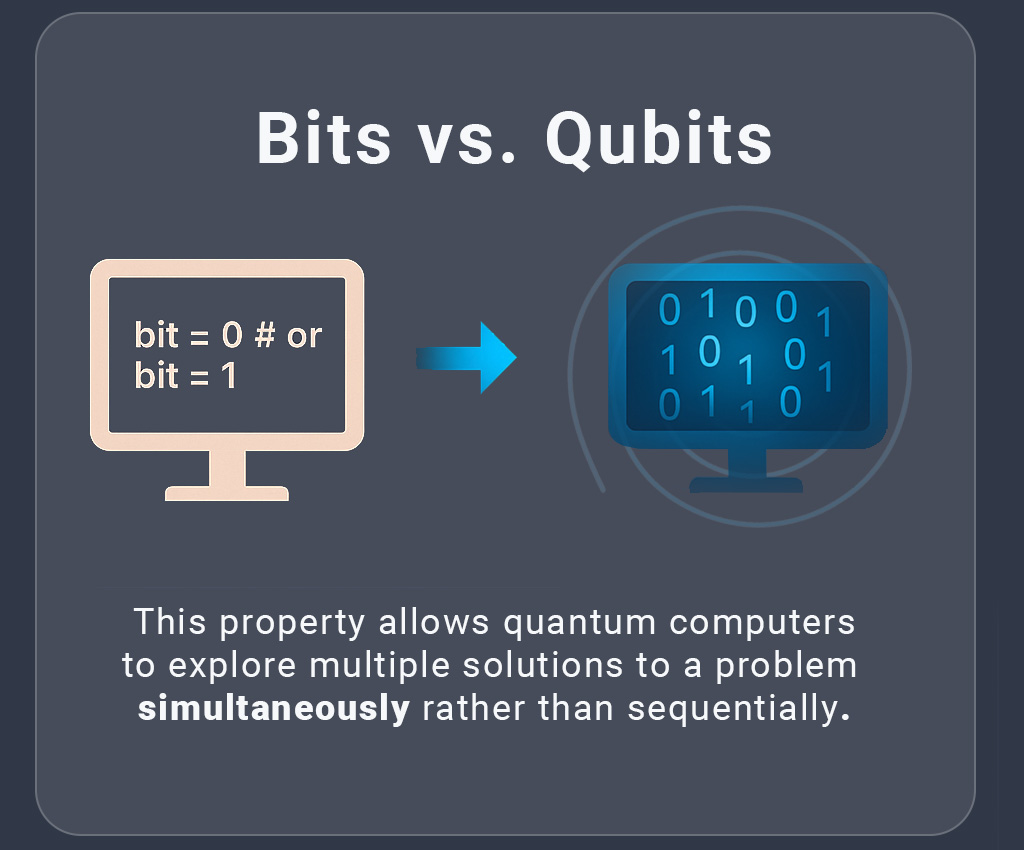Right now, in laboratories around the world, quantum computers are tackling problems so complex that even our most powerful supercomputers would need thousands of years to solve them. Much like the brain-computer interfaces we explored in our last Digital Peace article, this may sound like science fiction. But it isn’t. Quantum computing represents one of the most profound technological shifts of our time, with implications that stretch far beyond the realm of computer science into the very fabric of global security, economic power, and international peace.
But what exactly are these machines doing, and why does it matter for the rest of us? For people concerned with privacy, power, and peace in the digital age, understanding quantum computing is no longer optional.
Why Quantum Computing Matters
Quantum computers are not simply faster versions of our laptops or even our supercomputers. They work in a completely different way. Instead of checking one possible answer at a time, like walking through a maze step by step, they can check many paths at once. This allows them to solve certain really hard problems much faster than normal computers.
Quantum computer applications are fascinating.
In contrast to traditional computers, quantum computers open up entirely new possibilities, enabling researchers to tackle challenges once considered too complex to simulate, such as designing new medicines or optimizing large-scale logistics networks.
Although quantum computers are not yet routinely transforming drug development or material science, researchers are making progress in modeling molecular structures and chemical reactions at a level of detail previously impossible, raising hopes for breakthroughs in treatments for cancer and neurodegenerative diseases.
Quantum simulations are being explored to help discover next-generation battery materials that could improve electric vehicle range, though these advances are still in the experimental stage.
For logistics, companies like Mercedes-Benz and ZF Friedrichshafen are piloting quantum-inspired algorithms to optimize delivery routes and production processes using real-time data on traffic, weather, and demand. Early results suggest possible reductions in costs and delivery times, sometimes by up to 30%, though full quantum solutions are not yet standard.
When it comes to artificial intelligence and big data, quantum computing is being investigated as a way to accelerate tasks like image recognition and language processing, especially for chaotic or unstructured datasets such as social media, but these applications remain largely in the research phase. Overall, while quantum computing holds enormous promise for science and industry, most real-world impacts are still on the horizon rather than in widespread use today.
Recent advancements have accelerated the field dramatically. In 2024-2025 alone, we’ve seen quantum processors reach new milestones in qubit counts and error reduction, bringing us closer to practical quantum advantage. As Drífa Atladóttir (2024) argues in her policy paper for the ICT4Peace Foundation,
“The rapid advancement of quantum technologies demands swift action. Given that these technologies are in their nascent stages, now is the time to act”. 1
This urgency stems from quantum computing’s dual-use nature. The same technology that could revolutionize climate modeling, drug discovery, and materials science could also undermine the cryptographic systems that secure our digital world. Right now, we’re facing what experts call the “cryptographic cliff”: Quantum computers will crack the encryption that protects everything from your bank account to state secrets. As quantum capabilities advance, they raise profound questions about digital sovereignty, global security, and the potential for new forms of technological inequality.
And history gives us a hint about what might come next. Like many breakthrough technologies before it, quantum computing is likely to start in the hands of a few, mainly large corporations and wealthy nations. The infrastructure requirements for quantum computing, including ultra-low temperature systems, specialized materials, and highly skilled personnel, create natural barriers to democratization. Unlike classical computing, which eventually became accessible through miniaturization and cost reduction, quantum systems may remain centralized in specialized facilities, limiting direct access for smaller nations and organizations. Countries without their own quantum capabilities might end up completely dependent on quantum cloud services from the big players.
Any serious conversation about peaceful digital futures needs to include quantum computing. This emerging technology quietly raises difficult but necessary questions about power, access, and control: How will these incredibly powerful machines change global security and our digital systems? Can we actually use their game-changing abilities without creating new dangers? And the key question: Will quantum technology help the common public good, or will it just make the digital divide even worse?
This article breaks down what quantum computing is, why it’s fundamentally different from today’s machines, and what’s at stake as we approach the next frontier of digital transformation: from encryption and global security to technological inequality and governance.
What Is Quantum Computing? A Beginner-Friendly Guide
To understand quantum computing’s implications, we first need to grasp its fundamentals in accessible terms.
Not just 0 or 1. Quantum logic redefines what’s possible
Classical computers, from smartphones to supercomputers, process information using bits, which can be either 0 or 1. Quantum computers, overcome this dichotomy by using quantum bits or “qubits”, which can exist in multiple states simultaneously thanks to a quantum property called superposition.
Think of a classical bit as a coin that’s either heads or tails. A qubit is like a spinning coin: it’s potentially both heads and tails until you stop it and look. This property allows quantum computers to explore multiple solutions to a problem simultaneously rather than sequentially.


Another key quantum property is entanglement, famously described by Einstein as “spooky action at a distance“. When qubits become entangled, the state of one instantly influences the state of another, regardless of the distance separating them. This creates powerful correlations that quantum algorithms can exploit.
These properties enable quantum parallelism, i.e. the ability to process vast amounts of information simultaneously, which gives quantum computers their potential advantage for certain problems.
Power and Potential
Quantum computers aren’t universally superior to classical computers. Rather, they excel at specific tasks, including:
- Factoring large numbers (breaking encryption)
- Optimization problems (logistics, financial modeling)
- Simulating quantum systems (drug discovery, materials science)
- Searching unsorted databases
Perhaps the most well-known quantum algorithm is Shor’s algorithm, which can theoretically break RSA (Rivest–Shamir–Adleman) encryption, the very system protecting much of our digital communications. As Atladóttir (2024) notes, “This algorithm can theoretically compromise some public-key cryptography algorithms, including the RSA cryptosystem”, which is “one of the most widely used asymmetric encryption systems… commonly used in data encryption of e-mail and other digital transactions over the Internet” .
Current Limitations
Despite their promise, today’s quantum computers face significant challenges:
- Quantum decoherence: Qubits are extremely fragile and lose their quantum properties (decohere) when they interact with their environment, leading to errors.
- Error rates: Current quantum processors have high error rates, limiting their practical utility.
- Scalability: Building large-scale quantum computers with many qubits remains technically challenging.
We currently live in what experts call the NISQ (Noisy Intermediate-Scale Quantum) era, characterized by quantum computers with dozens to hundreds of qubits that are too error-prone for many practical applications (Preskill, 2028). 2
State of the Art in 2025
As of 2025, leading quantum processors have reached several hundred physical qubits, though these still suffer from significant error rates. Major players in the field include:
- Tech giants: IBM, Google, Microsoft, Amazon
- Specialized quantum companies: IonQ, Rigetti, PsiQuantum, Xanadu
- National initiatives: US National Quantum Initiative, China’s quantum programs, EU Quantum Flagship
Recent milestones include improved error correction techniques and the first demonstrations of quantum advantage for commercially relevant problems in optimization and simulation (Baker, 2025). 3
Timeline for Applications
Experts generally agree on a rough timeline for quantum applications:
- Near-term (1-5 years): Quantum simulators for specific scientific problems; limited optimization applications
- Medium-term (5-15 years): More robust quantum advantage in materials science, chemistry, and financial modeling
- Long-term (15+ years): Fault-tolerant quantum computers capable of running Shor’s algorithm at scale
As the Mark Patrick for the Engineering & Technology journal noted in April 2025,
“The quantum supremacy milestone will severely compromise our existing digital security mechanisms, so another race is on to build secure solutions that are resistant to quantum computing”. 4
The Encryption Challenge: Quantum Computing and Cybersecurity
Current Encryption Landscape
Modern digital security relies heavily on public-key cryptography. Systems like RSA and ECC (Elliptic Curve Cryptography) secure everything from banking transactions to government communications. These systems are based on mathematical problems that are extremely difficult for classical computers to solve, such as factoring large numbers.
This cryptographic infrastructure underpins virtually all secure digital communications, from HTTPS websites to encrypted messaging apps to secure government and military networks. Our digital economy and national security systems depend on the continued strength of these encryption methods.
Quantum Threat to Encryption
Shor’s algorithm, running on a sufficiently powerful quantum computer, could break these cryptographic systems by efficiently solving the underlying mathematical problems. While large-scale, fault-tolerant quantum computers capable of running Shor’s algorithm don’t exist yet, their eventual development poses a serious threat.
As Atladóttir (2024) warns, “There is a growing apprehension that adversaries may be collecting encrypted data with the intent to decrypt it in the future, a strategy known as ‘store now, decrypt later'”. This means sensitive information transmitted today could be compromised years later when quantum computers become powerful enough.
In May 2025, ISACA (Information Systems Audit and Control Association) warned that “quantum computing poses major cybersecurity risk, as few firms are ready” (Industrial Cyber, 2025).5 Their survey found that over two-thirds (67%) of cybersecurity professionals anticipate that quantum computing could increase or shift cybersecurity risks over the next decade (ISACA, 2025).6
Quantum Supremacy and Its Implications
Quantum supremacy (or quantum advantage) refers to the point at which quantum computers can solve problems that classical computers cannot solve in a reasonable timeframe. While early demonstrations of quantum supremacy involved artificially constructed problems, we’re moving toward practical quantum advantage for real-world applications.
Reaching true quantum supremacy for cryptographically relevant problems would mark a fundamental shift in the cybersecurity landscape, undermining current digital security mechanisms and requiring entirely new protective approaches.
The Cryptographic Cliff
The race between quantum computing advancement and post-quantum cryptography deployment
Post-Quantum Cryptography Efforts
Recognizing this threat, cryptographers have been developing “post-quantum” or “quantum-resistant” algorithms designed to withstand attacks from quantum computers. The U.S. National Institute of Standards and Technology (NIST) has been leading a standardization process for these algorithms since 2016.
As of 2025, NIST has standardized several post-quantum cryptographic algorithms, and organizations are beginning to implement them. According to The Quantum Insider (2024), “In 2025, enterprises will start deploying post-quantum cryptography at scale – moving out of the ‘discovery’ phase at the start of their adoption roadmaps”. 7
However, transitioning global infrastructure to quantum-resistant encryption is a massive undertaking. Legacy systems, implementation challenges, and varying levels of awareness and resources make this a complex global security challenge.
Digital Sovereignty Implications
The quantum encryption challenge has profound implications for digital sovereignty, i.e. a nation’s ability to control its digital destiny and protect its citizens’ data. Nations without access to quantum technology or the resources to implement post-quantum cryptography may find themselves increasingly vulnerable.
As the “Qubits for Peace” report highlighted in May 2025, “First, their security infrastructure might become increasingly vulnerable as quantum computing threatens to break existing encryption protocols”. 8 This creates a new dimension of national security risk, particularly for developing nations.
Quantum Computing: Global Progress or Power Imbalance?
Quantum computing offers tremendous potential benefits across multiple domains:
- Climate science: More accurate climate models and materials for carbon capture
- Healthcare: Accelerated drug discovery and personalized medicine
- Energy: Better batteries and more efficient solar cells
- Optimization: Improved logistics, traffic management, and resource allocation
These applications could address some of humanity’s most pressing challenges. As Atladóttir (2024) notes, quantum technologies “promise to revolutionize various sectors, such as national security, healthcare, and communications” .
Dual-Use Dilemma
However, quantum technologies also present classic dual-use dilemmas: technologies developed for beneficial purposes that can also be used for harmful ones. The same quantum computers that optimize drug discovery could break encryption protecting human rights activists. Quantum sensors designed for medical imaging could enhance military surveillance capabilities.
This dual-use nature creates complex governance challenges. As Atladóttir (2024) observes, quantum technologies “offer remarkable opportunities for technological advancement, but they also expose nations to significant threats, including risks to national security, economic competitiveness, and societal welfare”.
Risk of a New Digital Arms Race
The strategic importance of quantum technologies has already triggered what some observers call a “quantum race” among major powers. The United States, China, and the European Union have all launched multi-billion-dollar quantum initiatives, framing quantum leadership as a national security imperative.
This competitive dynamic risks creating a quantum arms race, where geopolitical rivals pursue quantum capabilities primarily for strategic advantage rather than common benefit. History suggests that technological arms races often undermine international cooperation and can lead to security dilemmas where actions taken by one state to increase its security decrease the security of others.
Power Concentration Concerns
The quantum landscape is currently dominated by a small number of wealthy nations and large technology companies. This concentration raises serious concerns about equitable access to quantum technologies and their benefits. According to the European Centre for International Political Economy (ECIPE) policy brief, public investment in quantum tech is nearly three times higher than private,9 defying typical R&D trends in other emerging technology sectors such as AI or Cybersecurity. 10

- China leads globally with $15B in public investment, far ahead of others.
- The EU ranks second, exceeding $10B, including national contributions and the €1B Quantum Flagship.
- The US on place 3 shows balanced investment (~$5B public & $5B private).
- Germany alone contributes over 60% of EU’s total, focusing especially on quantum sensing for industrial use.
- The UK follows with over $4B in public funding.
- Other key players: South Korea, Japan, Russia, and Canada.
The “Qubits for Peace” report warned that quantum technology is “deepening the global divide” between technological haves and have-nots. This divide could exacerbate existing inequalities and create new forms of technological dependency.
As quantum computing advances, questions of who controls this technology, who has access to it, and who benefits from it become increasingly important for global justice and stability.
Preparing for the Quantum Future: Governance and Digital Peace
Governance Frameworks
Effective governance of quantum technologies requires both national strategies and international coordination. Atladóttir’s (2024) analysis of national quantum frameworks identifies seven key pillars for quantum governance:
- Workforce Development: Investing in education and training
- Research Support: Ensuring sustained investment in quantum research
- Innovation and Development: Promoting public-private partnerships
- Security and Risk Management: Addressing potential risks proactively
- Inclusivity and Diversity: Setting standards for accessibility and inclusivity
- International Collaboration: Forming global partnerships
- Ethics and Responsible Innovation: Considering social and environmental impacts
However, current governance efforts often focus primarily on economic competitiveness and national security, with less attention to ethical considerations, inclusivity, and international cooperation.
Plus, building frameworks is only half the battle: ensuring that powerful technology companies actually adhere to these standards and quantum development serves the public interest – rather than just national competitiveness or corporate advantage – will require robust enforcement mechanisms, international coordination, and sustained public pressure.
Digital Peace Approach to Quantum
A Digital Peace approach to quantum governance would prioritize:
- Transparency: Open research and clear communication about capabilities and limitations.
- Inclusivity: Ensuring diverse participation in quantum development and governance.
- Equity: Addressing the “quantum divide” and ensuring broad access to benefits.
- Security: Protecting against malicious uses while enabling beneficial applications.
- Sustainability: Considering long-term impacts on society and the environment.
This approach recognizes that technological development is not neutral, it reflects and reinforces existing power structures unless deliberately designed to do otherwise.
Role of Civil Society and Academia
Quantum governance cannot be left solely to governments and industry. Civil society organizations, academia, and the public have crucial roles to play in:
- Increasing quantum literacy beyond technical experts
- Ensuring diverse perspectives in quantum policy discussions
- Advocating for equitable access to quantum technologies
- Monitoring potential misuses and holding powerful actors accountable
Ensuring ethical quantum governance requires a global conversation, one that includes voices from diverse disciplines, cultures, and lived experiences. This mirrors broader calls for inclusivity in emerging tech governance across fields like neuroethics and AI.
Call to Action: Prepare Now
The time to shape quantum governance is now, while the technology is still developing. As Atladóttir (2024) argues:
“Currently, QTs are at a nascent stage, providing a rare chance to shape their development to benefit the public interest, bolster national security, and drive economic growth“.
Specific actions needed include:
- Accelerating the transition to quantum-resistant cryptography
- Developing international norms and standards for quantum technologies
- Investing in quantum education and workforce development
- Ensuring diverse participation in quantum research and governance
- Supporting multidisciplinary research on quantum ethics and impacts
The Quantum-Safe Cybersecurity guide emphasizes that preparation cannot wait. Organizations need to protect their data from quantum computing threats now, not when the threat materializes. 11
A Quantum Future for All
Quantum computing stands at a crossroads. It could exacerbate digital divides, trigger new arms races, and undermine digital security. Or it could help solve humanity’s greatest challenges, from climate change to disease, while strengthening international cooperation.
The path we take depends on the governance frameworks we build today. By approaching quantum development through a Digital Peace lens, i.e. prioritizing equity, security, and human wellbeing, we can harness this revolutionary technology for the benefit of all humanity, not just the privileged few.
The quantum future is not predetermined. It will be shaped by the choices we make now about how to develop, deploy, and govern these powerful technologies.
It’s time to rethink the future we’re building.
References
- Atladóttir, D. (2024). Navigating the Quantum Wave: A Policy Maker’s Guide for the Responsible Governance of Quantum Technologies. ICT4Peace Foundation. https://ict4peace.org/wp-content/uploads/2024/05/Atladottir-Navigating-The-Quantum-Wave.pdf
- Preskill, J. (2018). Quantum Computing in the NISQ era and beyond. Quantum, 2(2), 79. https://doi.org/10.22331/q-2018-08-06-79
- Baker, B. (2025). World Quantum Day 2025: Industry Weighs In. Iotworldtoday.com. https://www.iotworldtoday.com/quantum/world-quantum-day-2025-industry-weighs-in
- Patrick, M. (2025, April 30). Industry insight: Quantum computing rise sparks security fears amid skills shortage. Engineering and Technology Magazine. https://eandt.theiet.org/2025/04/30/industry-insight-quantum-computing-rise-sparks-security-fears-amid-skills-shortage
- Ribeiro, A. (2025, May). ISACA warns that quantum computing poses major cybersecurity risk, as few firms are ready. Industrial Cyber. https://industrialcyber.co/critical-infrastructure/isaca-warns-that-quantum-computing-poses-major-cybersecurity-risk-as-few-firms-are-ready/
- ISACA. (2025). Quantum computings rapid rise is a risk to cybersecurity and business stability. ISACA. https://www.isaca.org/about-us/newsroom/press-releases/2025/quantum-computings-rapid-rise-is-a-risk-to-cybersecurity-and-business-stability
- Swayne, M. (2025). “Qubits For Peace”: Researchers Warn Quantum Technology Is Deepening The Global Divide. Quantum Insider. https://thequantuminsider.com/2025/05/05/qubits-for-peace-researchers-warn-quantum-technology-is-deepening-the-global-divide/
- Swayne, M. (2025). “Qubits For Peace”: Researchers Warn Quantum Technology Is Deepening The Global Divide. Quantum Insider. https://thequantuminsider.com/2025/05/05/qubits-for-peace-researchers-warn-quantum-technology-is-deepening-the-global-divide/
- Erixon, F., Dugo, A., Pandya , D., & du Roy , O. (2025, March 27). Benchmarking Quantum Technology Performance: Governments, Industry, Academia and their Role in Shaping our Technological Future. Ecipe.org; European Centre for International Political Economy. https://ecipe.org/publications/benchmarking-quantum-technology-performance/
- Arcuri, G., & Yoon, J. (2024). Innovation Lightbulb: Breaking Down Private Sector Research and Development. Www.csis.org. https://www.csis.org/analysis/innovation-lightbulb-breaking-down-private-sector-research-and-development
- Koonthamattam, L. (2025, January 14). Quantum-Safe Cybersecurity: Essential CISO 2025 Guide. CybelAngel. https://cybelangel.com/quantum-safe-cybersecurity/








I appreciate the awareness the article contributes to the ongoing discussion surrounding quantum computing. This emerging technology has significant implications and consequences for global society. As Alissa noted in the article, “This mirrors broader calls for inclusivity in emerging tech governance across fields like neuroethics and AI.”
Reflecting from both the lens of technology and peacebuilding, my thoughts are drawn to AI, which quantum computing is poised to amplify. By providing unprecedented hardware and processing power, quantum computing intensifies existing challenges in AI—particularly those related to transparency, explainability, bias, and inclusion. Addressing the ethical and governance concerns of AI is foundational to tackling similar issues in quantum computing, as the two are deeply interconnected: the advancement of one enhances the capacity—and complexity—of the other.
What is required is a reflective form of moral accountability grounded in human values and a collective societal ethic. This calls for shared responsibility among those with privilege and influence across the private sector, government, academia, and civil society. Together, we must prioritize human dignity over profit and unity over division. In doing so, I believe we can create a future in which all people may prosper and flourish.
Dear Trent,
Thank you so much for taking the time to read through the article and for your thoughtful reflection.You’ve captured a crucial point: the interdependence between quantum computing and AI doesn’t just multiply technical capacity, but also ethical complexity.
Your call for moral accountability grounded in human values resonates deeply with the spirit of the article. As you rightly point out, shared responsibility across sectors is essential if we are to steer these technologies toward inclusive and peace-oriented futures. Let’s keep on working towards a digital future that reflects integrity, equity, and the dignity of all.
We truly appreciate your contribution to this important conversation!